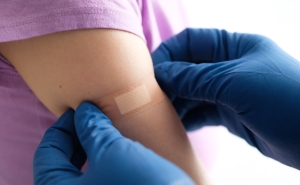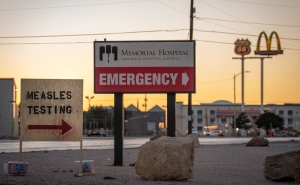What You Need to Know About Monkeypox

Monkeypox is nothing new, and the virus is endemic in several countries. But when cases started appearing beyond the expected places—and among people who didn’t travel to those endemic regions—researchers paid attention.
Now, researchers are trying to learn more about how and why the virus is spreading. In this Q&A, adapted from a bonus episode of Public Health On Call, Lindsay Smith Rogers talks with Eric Toner, MD, an expert in bioterrorism and emerging infectious diseases at the Johns Hopkins Center for Health Security, about what monkeypox is, how it spreads, and why these outbreaks are important to know about but should not be a cause for alarm.
What is monkeypox? What do we need to know?
Well, first of all, monkeypox does not come from monkeys. It’s called monkeypox because it was first isolated from a monkey in Africa, but the reservoir for it is in rodents, specifically rodents in Central and West Africa.
We’ve been aware of monkeypox for decades, and we have been interested in it mostly because it’s a cousin of smallpox. It is a related orthopoxvirus. The symptoms, although somewhat less severe, are quite similar to smallpox. In most cases, it causes relatively mild illness, meaning most people don’t end up in the hospital with it.
There are two strains: one in the Congo Basin, which tends to be more severe, and another in West Africa, which is less severe. And that is the strain that seems to be causing the current outbreak.
What are the symptoms? Is it fatal?
It starts with a flu-like illness, fever, feeling bad, but also pronounced swelling of the lymph nodes, and that’s different from smallpox. After several days, a rash appears that looks like chickenpox or smallpox, and that progresses over the course of a week or two. And then finally, the pox crust over and people recover.
It is said that the West African strain, the one that we’re dealing with, has a 1% mortality rate. But that is data for people in Africa. In the cases that have occurred in the developed world, nearly all have been fairly mild, and severe illness and death from it is rare.
It has a long incubation period, somewhere between one and two weeks, which is good because it gives us a lot of time to to intercede if we know someone’s had contact with a case, and we have both vaccines and antiviral treatments that are effective.
We’d like to do what we did with smallpox to eradicate it: ring vaccination—if you see a case and then you vaccinate the people around that case, you can stop the spread of the disease. Unlike many other diseases, you can vaccinate somebody after they’ve been exposed, and it will stop or at least lessen the severity of the disease.
There’s little doubt that we can contain and stop this outbreak. It’s not of great concern for the general public, although certainly it’s of concern to people in public health and frontline health care workers.
Public Health On Call
This article was adapted from the May 23 episode of Public Health On Call Podcast.
How does it spread?
It spreads through large respiratory droplets and bodily fluids, so mostly it spreads through close or intimate contact with other people. It’s not highly contagious—nothing like COVID, for example. Within a household, less than 10% of household contacts get infected.
If someone were coughing in your face, or spit or drooled on you, probably also kissing—it spreads through those kinds of contacts rather than just being in a room with somebody. But it does also persist on clothing and on bed linens, for example.
Why is this in the news so much right now?
It’s the largest outbreak that we’ve seen outside of Africa in recent history. This all started just a few days ago with a family in London, where several members of the family got infected after one family member traveled from Nigeria, where monkeypox is endemic. But then cases started popping up in many other locations: Portugal, Spain, now Sweden, one case in the U.S., many suspected cases in Canada, and many more suspected cases elsewhere in Europe. It’s an unusually large outbreak for monkeypox, and only one of these people had a travel history to an endemic area. So the presumption is that everybody else is being infected through some sort of community transmission.
Are certain groups more at risk?
In Africa, most cases have been in children, but that may be because older people had been previously vaccinated for smallpox. We don’t know if it’s something that is inherent to the pathogen, or whether it is related to prior vaccination or behavior.
Is it painful?
Typically it is not excruciatingly painful. There’s a broad spectrum of illness: Some people have only one or two pox, while others are covered in pox. Obviously those people who have it everywhere are miserable, and those people who have just a few don’t feel that bad at all.
What are public health experts like you watching right now?
We’re trying to understand the transmission, which is the most important thing right now. Of the cases that are now known, the majority of them are men who’ve had sex with men, so there is a question of whether this is being transmitted sexually, which has never been known before. Or it could simply be close contact within a network.
It could also be that because monkeypox can look initially like the rash from syphilis, people who are particularly attuned to and watching for signs of syphilis would seek medical attention sooner than other people. So we don’t yet know what’s going on, but it has spread farther than we would have expected or have seen in the past. We’re trying very hard to understand the extent of transmission: Are we seeing most of the actual cases? Or are we seeing the tip of the iceberg? We don’t really know that yet.
And then the question is, is this unprecedented outbreak because of a change in the virus? Or is it because of a change in behavior? Or is it because of better surveillance, and we’re just finding these cases that we would previously have missed?
You mentioned that the smallpox vaccination is helpful, but if the virus has changed, would that still be the case? Could we potentially see widespread vaccination against smallpox?
To answer your first question, there’s no way to know at this point, but this does tend to be a very stable virus. Unlike COVID, or flu that’s mutating constantly, the orthopoxviruses tend to be quite stable. I think the expectation is that the vaccines would still be effective.
It is very unlikely that we would do widespread vaccination. Even during the smallpox eradication program in the ’60s and ’70s, we rarely did mass vaccination. What we did was ring vaccination—that is, we vaccinated those people who had direct contact with a known case. That’s how smallpox was eradicated. In the UK, they are vaccinating people who’ve been in contact with known cases. It is certainly possible that we could do that in the United States and other countries.
Is this a one-time vaccination?
There are three vaccines available. One vaccine is actually licensed for monkeypox as well as smallpox and is a two-shot vaccine, one shot initially and another shot four weeks later. The other vaccines are one-time vaccinations.
Is there anything else people should be aware of?
No, people in general don’t really need to be that aware of this. Local and state health departments certainly need to be aware of it, and I’m sure they are on the lookout for it. Frontline health care workers should be aware of it and should be taking travel histories; someone presenting with fever and rash ought to be asked a few more questions. But for the general public, I think this is not a concern.
Stay up-to-date with monkeypox via the Center for Health Security's monkeypox email updates and learn more from their one-pager.
Lindsay Smith Rogers, MA, is the producer of the Public Health On Call podcast and the associate director of content strategy for the Johns Hopkins Bloomberg School of Public Health.





